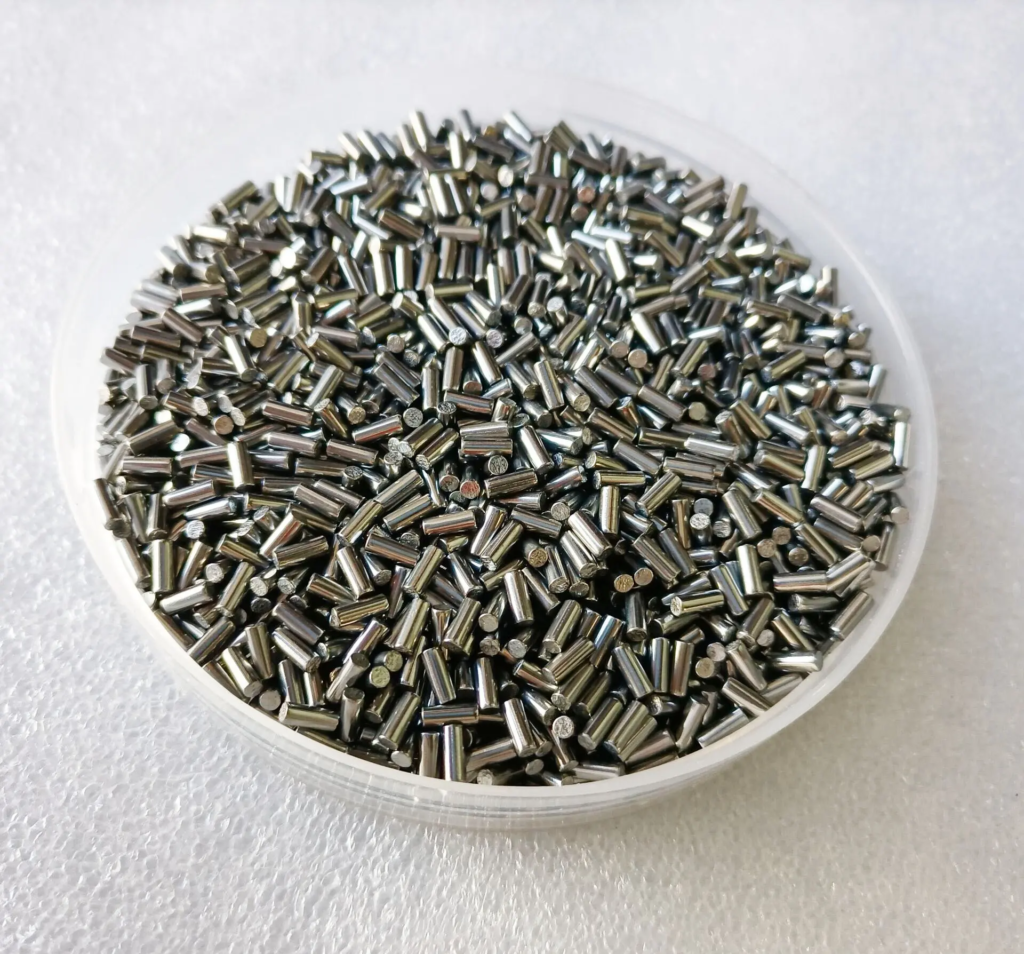Hafnium granules pellets for evaporation coating
Hafnium granules and pellets are premium-quality materials tailored for use in evaporation coating processes. These high-purity forms of hafnium (≥99.9%) are ideal for Physical Vapor Deposition (PVD) and other vacuum coating techniques. Their uniform composition ensures consistent evaporation rates, making them suitable for creating thin films in optics, semiconductors, and wear-resistant coatings.
Hafnium products including hafnium wire, Spherical Hafnium Hf Powder, and Hafnium Sponge are available for sale.
| Formula | Hafnium, Hf |
CAS Number | 7440-58-6 |
Purity | 99.9% min |
Appearance | Gray Steel, Metallic |
Sizes | < 10 mm |
Shape | Pellet, Granules |
Melting Point | 2222 C |
Density | 13.31 g/cm 3 |
Description of Hafnium granules pellets
Hafnium granules and pellets are high-purity forms of hafnium metal, available in irregular (granules) or uniform cylindrical (pellets) shapes. Hafnium is a rare and highly corrosion-resistant transition metal with excellent thermal and neutron absorption properties, making it indispensable in nuclear, aerospace, and high-temperature applications. Its forms are widely used in thin-film deposition, alloying, and high-performance components.
Manufacturing method of Hafnium granules pellets
Raw Material Selection
- High-purity hafnium (>99.9%) derived from zirconium ore is selected to ensure low impurity levels, particularly low zirconium content for nuclear applications.
Melting and Forming
- Hafnium is melted using vacuum arc melting or electron beam melting to remove impurities. Granules are produced by crushing or mechanical milling, while pellets are formed by casting or extruding into uniform shapes.
Surface Treatment and Grading
- Surface cleaning removes oxides, and materials are graded to precise size ranges, typically 1–10 mm for granules and 3–10 mm for pellets.
Main properties of Hafnium granules pellets
- Thermal Stability: Exceptional heat resistance, with a melting point of 2222°C.
- Corrosion Resistance: Resists oxidation and chemical attacks, even at high temperatures.
- Neutron Absorption: Excellent neutron capture cross-section, vital for nuclear applications.
Application of Hafnium granules pellets
Nuclear Industry
- Used in control rods and reactor components due to its superior neutron absorption and low activation properties.
Thin-Film Deposition
- Hafnium granules and pellets serve as evaporation materials for PVD and sputtering to produce protective and functional coatings in semiconductors, optics, and electronics.
Aerospace Components
- Alloying hafnium with titanium and other metals enhances high-temperature stability and strength in jet engines and spacecraft parts.
Superalloys and Heat-Resistant Alloys
- Essential for improving the mechanical properties of high-temperature alloys used in turbines and industrial furnaces.
Energy Storage
- Potential use in advanced energy storage technologies, such as solid-state batteries.
Hafnium granules pellets Scholar Articles
Hafnium and Hafnium Compounds
Abstract: Hafnium, Hf, is in Group 4 (IVB) of the Periodic Table as are the lighter elements, zirconium and titanium. Hafnium is a heavy gray-white metallic element never found free in nature. It is always associated with the more plentiful zirconium. The two elements are almost identical in chemical behavior. Hafnium is obtained as a by-product of the production of hafnium-free nuclear grade zirconium. The refining of hafnium for its principal uses is by van Arkel-de Boer process. Most hafnium compounds require no special safety precautions because hafnium is nontoxic under normal exposure. It is reported as having negative effect on the environment. Hafnium metal is used in alloying and in control rods for nuclear reactors. Hafnium oxide, hafnium carbide and hafnium nitride are the most important compounds of hafnium. They are the most refractory of all the compounds.

